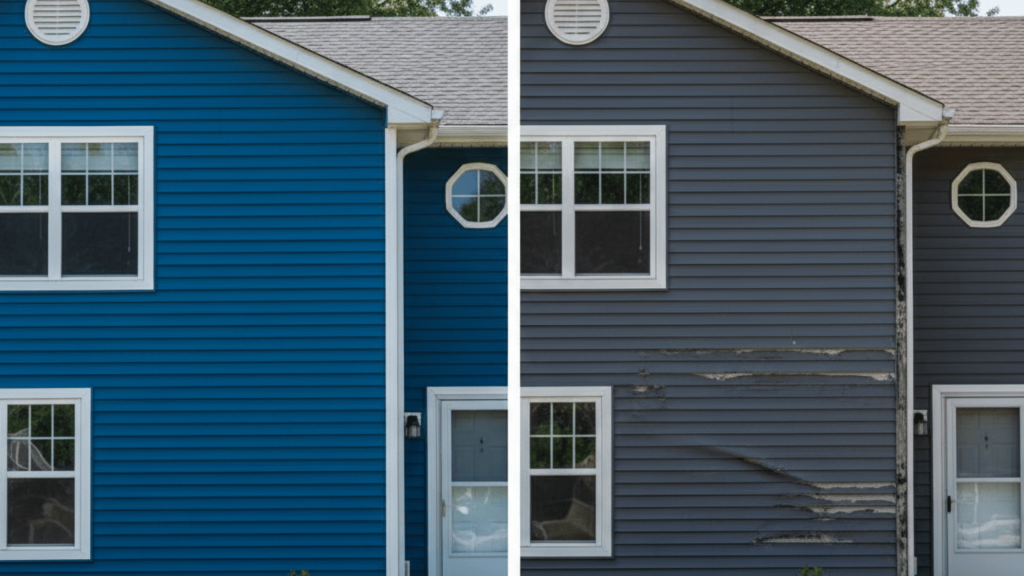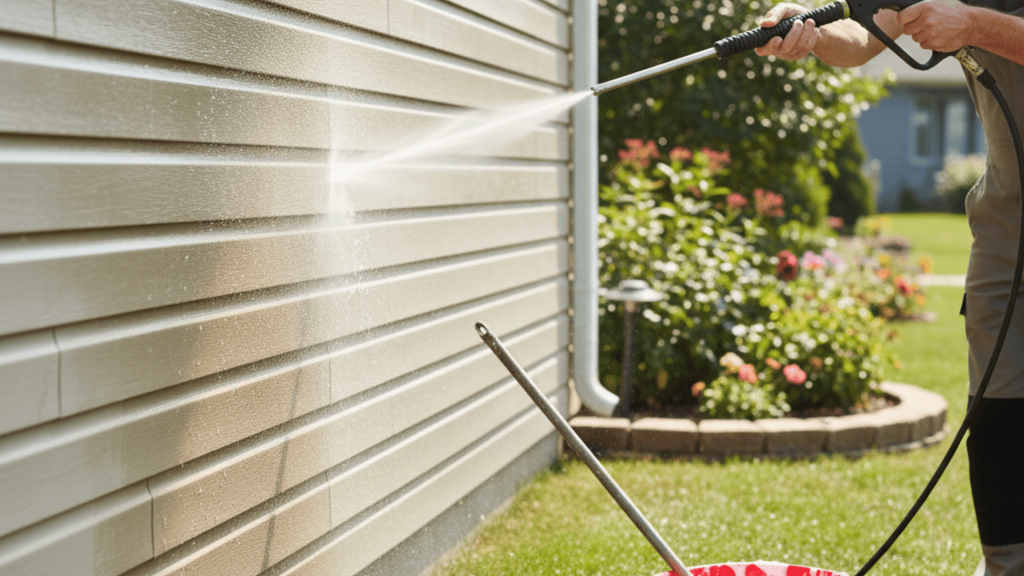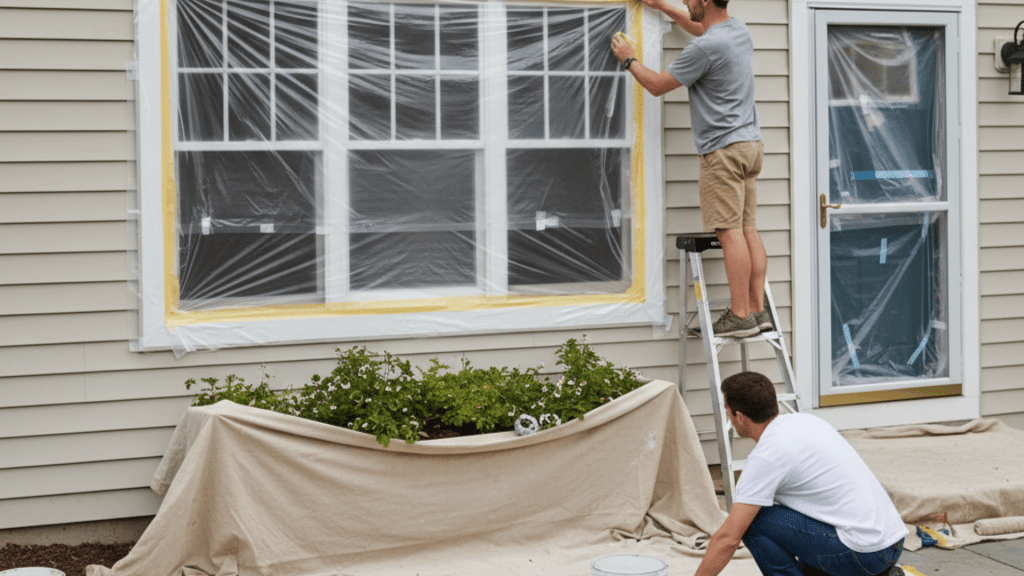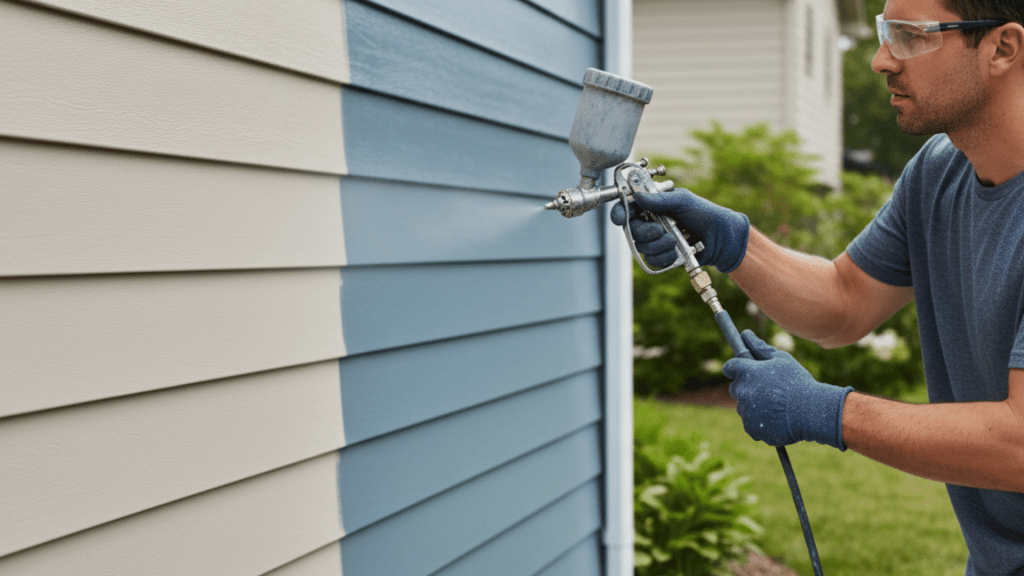Thinking about giving your home’s exterior a fresh look without the huge expense of replacing all the siding?
You’re in good company. Many homeowners wonder if they can simply paint their vinyl siding instead of tearing it off and starting from scratch.
The answer might surprise you: yes, you can paint vinyl siding, and it can be a smart choice if done correctly.
Learn everything you need to know about painting vinyl siding.
We’ll cover what vinyl siding is, whether it can be painted, the pros and cons, and a complete step-by-step process. By the end, you’ll know exactly how to tackle this project and give your home the makeover it deserves.
What Is Vinyl Siding?
Vinyl siding is a popular exterior covering made from plastic material called polyvinyl chloride, or PVC. It’s designed to protect your home from the weather while looking nice.
When manufacturers make vinyl siding, they add color throughout the material and apply a special finish on top.
This finish helps protect against sun damage and keeps the color looking fresh. Most vinyl siding can last 20 to 40 years if properly maintained.
Why do so many people choose vinyl siding?
It’s affordable compared to other options like wood or fiber cement. It also requires very little maintenance, no painting or staining needed under normal circumstances. Just an occasional wash with soap and water keeps it looking good.
Can Vinyl Siding Be Painted?
Yes, vinyl siding can definitely be painted, but there are important conditions to follow.
The key is using the right materials and techniques. You can’t just grab any paint and start brushing. Vinyl expands and contracts with temperature changes, so you need special paint that moves with it.
However, there are some important limitations. If your siding is very old, damaged, or brittle, painting might not be your best option. Also, check your manufacturer’s instructions or warranty information. Some manufacturers say painting will void the warranty.
You should also think about when replacement makes more sense than painting. If your siding has widespread cracks, warping, or rot underneath, these problems won’t be fixed by paint. In those cases, replacement is the better investment.
Pros and Cons of Painting Vinyl Siding

Before you decide to paint, consider both the benefits and drawbacks.
Pros:
- Affordable curb appeal boost. Painting costs much less than replacing all your siding. You can transform your home’s look for a fraction of the replacement cost.
- Color flexibility. Maybe you bought a house with outdated yellow siding, but you dream of a coastal blue look. Paint makes that possible without major construction.
- Extended aesthetic life. Even if your siding is structurally sound, it might look tired and faded. A fresh coat of paint can make it look new again and extend its visual appeal for years.
Cons:
- Warranty concerns. Many vinyl siding manufacturers will void your warranty if you paint. Check your warranty documents before starting.
- Ongoing maintenance. Unlike the original vinyl finish that can last decades, painted vinyl needs repainting every 7-10 years. You’re signing up for more work down the road.
- Warping risk. This is serious. If you choose the wrong color, especially dark colors, the siding can absorb too much heat and warp. Dark colors soak up the sun’s heat, which can damage vinyl that wasn’t designed for those temperatures.
Things to Consider Before You Start
Before buying paint and brushes, take time to evaluate a few important factors. Here’s a quick checklist to help you decide if painting is right for your vinyl siding:
| What to Check | What to Look For | Why It Matters |
|---|---|---|
| Siding Condition | Cracks, brittleness, loose panels | Paint won’t fix structural problems—repair damaged sections first |
| Color Choice | Same shade or lighter than the current color | Darker colors absorb heat and can cause warping |
| Climate | Sun exposure, humidity, temperature swings | Affects how long your paint job will last |
| Cost | DIY: $1,500-$4,000 Professional: $3,000-$7,000 Replacement: $15,000-$30,000 |
Painting is cheaper, but is it worth it for your situation? |
| Warranty | Manufacturer restrictions | Painting may void your warranty |
The Complete Process: How to Paint Vinyl Siding (Step-by-Step)
Ready to paint? Follow these steps for the best results.
Step 1: Cleaning and Preparation

This is non-negotiable. Use a pressure washer or garden hose with a brush attachment to remove all dirt, chalk residue, and mildew.
For stubborn mildew, use a mixture of water, detergent, and a little bleach. Let the siding dry completely for at least 24 hours.
While it dries, walk around and inspect for any cracked, loose, or damaged panels. Replace these sections or secure them properly, and fill any holes with appropriate filler.
Step 2: Protecting Surrounding Areas

Use painter’s tape to protect windows, doors, trim, lights, and outlets. Lay drop cloths or plastic sheeting over landscaping, walkways, and anything else near the house.
Taking time to mask properly saves you from cleanup headaches later. Make sure the siding is completely dry before you start taping.
Step 3: Applying Paint

This is where your preparation pays off. First, if you’re making a dramatic color change or your siding is very chalky, apply primer and let it dry completely.
Then choose exterior acrylic or latex paint specifically labeled as “vinyl-safe”; this is critical.
These paints expand and contract with the siding. Don’t paint in direct, hot sunlight or when rain is expected within 24 hours. Apply two thin, even coats rather than one thick coat.
Let the first coat dry completely before applying the second, usually 4 to 8 hours, but check your paint can for specific drying times.
Step 4: Finished Look and Maintenance

Once your paint job is complete and fully dried, remove all tape and drop cloths carefully.
To keep it looking great, clean your painted siding gently once a year with mild soap and water using a soft brush or garden hose.
Inspect it periodically for any chips or peeling, touching up small areas as needed.
Expect to repaint every 7-10 years, depending on your climate and sun exposure. This is shorter than the original vinyl finish, which can last decades without attention, but it’s still a worthwhile investment for a beautiful home exterior.
Choosing the Right Paint and Cost Considerations
Not all paints work on vinyl siding. Here’s what you need to know.
What “vinyl-safe” means
This term indicates that the paint has the flexibility to expand and contract with temperature changes.
It also has UV resistance to prevent fading and is formulated to work with vinyl’s unique properties. Regular exterior house paint doesn’t have these features.
Color guidance you must follow
Stick to the same shade or lighter than your current siding color. This isn’t just a suggestion. It’s a safety requirement.
Darker colors can cause the vinyl to absorb heat and warp, leading to expensive damage. When in doubt, go lighter.
Typical cost ranges
For DIY projects, expect to spend $800 to $3,000 on materials, depending on your home’s size. This includes paint, primer (if needed), cleaning supplies, brushes, rollers, tape, and drop cloths.
For professional painting, costs typically range from $3,000 to $7,000 for an average-sized home. Larger homes or those with complex architectural details will cost more. Professional painters bring experience, proper equipment, and efficiency.
Full vinyl siding replacement typically costs $15,000 to $30,000 or more, depending on your home’s size and the quality of new siding you choose.
Painting is clearly the more budget-friendly option if your siding is still in good structural condition.
Conclusion
Yes, you can paint vinyl siding when you use the right approach, proper materials, and careful preparation.
The key is understanding that vinyl siding has special requirements—it needs flexible, vinyl-safe paint in lighter colors to avoid warping.
Remember these important takeaways: always clean thoroughly before painting, choose paint specifically made for vinyl, stick to lighter colors, and expect to repaint every 7-10 years.
Weigh the costs and benefits against replacement, especially considering warranty implications.
Ready to give your home a fresh new look? Take time to carefully evaluate your siding’s condition and plan your project properly.

